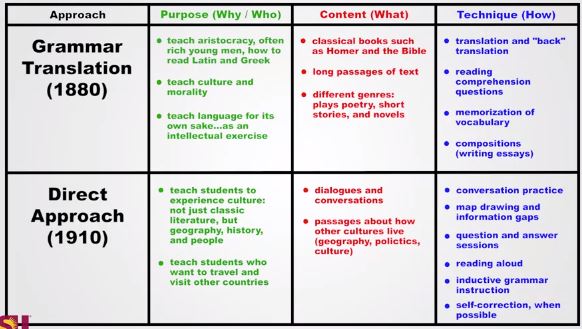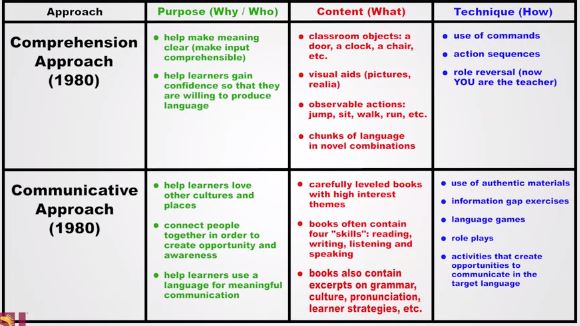Teach English Now! Course #2 Theories of Second Language Acquisition
Lecturers: Dr. Shane Dixon, Dr. Justin Shewell
In the direct approach, A teacher must make it clear to the learner that they are in charge of seeing this world and of expressing and sharing it. A teacher must make it clear that learners are in charge of their own learning. (my comment: I think it should be the goal of teaching no matter what kind of teaching methods are used. )
Things I learn: (words from the lecture)
- Language is a way to get to know different people. I want to learn your language so I can communicate with you and learn more about you. I have always been fascinated by other cultures,
- People learn a language when they care about it. A teacher should make learning fun and interesting.
- You help people remember a language by making your lessons memorable. You choose things they are interested in, and use those to help them learn a language. You make it fun, if students are having fun, hopefully they are engaged. They are motivated with the language, and that will help them to learn
- If you encounter students who really need to pass a test, then some of the strategies learned in the reading approach might be very attractive and even recommended. If learning just enough language to communicate quickly is attractive to you, there is still commercial products that use a lot of audio-lingual drills to allow you time to practice and practice quickly before your airplane lands. Please consider what your purpose and the purpose of your learners is first.
Week 1: The Swing of the Pendulum: A Brief Look at ESL History
Week 2: A Study in Contrasts: The Grammar Translation and Direct Approach
Week 3: A Study in Contrasts: The Reading and Audiolingual Approach
Week 4: A Study in Contrasts: The Cognitive and Affective-Humanistic Approach
Week 5: A Study in Similarities: The Comprehension and Communicative Approach
Week 6: Assessment
- Three basic elements are purpose, content, and technique ( who, what, why, and how)'
- purpose shapes both content and technique
Technique refers to the ways a teacher teaches. While purpose refers to why and who, and content refers to what, technique refers to how a language is learned and taught.
Although loosely based on Peter Elbow's The Believing and Doubting Game, we will call our game the Angel and Devil Debate.


Week 1: The Swing of the Pendulum: A Brief Look at ESL History
In art, we have two movements at extreme ends of the pendulum. First, we have abstract expressionism This type of art appeared around the 1940's and 1950's, at the end of World War II, and focused mostly on various shapes and colors, representing a mixture of emotions and expressions. Two famous works from this period in are Number 1, Lavendar Mist, done in 1950 by Jackson Pollack And Door to the River, done by Willem de Kooning in 1960.
At the other end of the pendulum, we have the photorealism movement. This type of art came out in direct contrast to the abstract expressionism movement. This type of art appeared in the 1960s and 70s and focused on creating recreations of realistic scenes. Often taken from a photograph, and adding artistic enhancements to make the scene even more vivid and lifelike. Two famous works from this movement are Self-Portrait, done in 1969 by Chuck Close, and McDonald's Pick-up, done in 1970. By Ralph Goings. As you can see, these two movements represent two extremes in art and the pendulum swung from one to the other rather quickly.
Week 2: A Study in Contrasts: The Grammar Translation and Direct Approach
One of the primary principles of the direct approach is that language learning should be done completely in the primary language.
Week 3: A Study in Contrasts: The Reading and Audiolingual Approach
The reading approach focused on explicit grammar instruction, while deemphasizing speaking. And the audio-lingual approach emphasized speaking while focusing on teaching grammar through dialogues.
Audio-langualism was heavily influenced by the behaviorist theories of B.F. Skinner who was a famous psychologist at that time. When you think of behaviorism, think of Pavlov's dogs.
The audio-lingual approach is based on the idea of language learning as habit formation(by repeat). There was a definite focus on speaking and oral ability, and reading and writing were almost completely ignored. There wasn't much focus on meaning, but a lot of focus on mimicry and pronunciation.
Students were taught by the use of lots of repetition drills, backward drills, build up drills, chain drills, single slot, and multi slot substitution drills, and transformation drills. They were asked to memorize dialogues and phrases. Minimal pairs were used to focus on pronunciation. By overlearning these dialogues and phrases and focusing on correct pronunciation, these language chunks became automatic and habitual.
single-slot substitution drill, where students replace one word or phrase for another in a line they have already memorized. the transformation drill, where teachers ask students to transform a line they have already memorized into a different grammatical form. ( I like swimming. Do you like swimming?). Chain drill or chain game. In this game, one student begins by saying a line, such as, I like swimming. The next student then repeats the first student's line and adds their own, such as, she likes swimming. I like watching television.
There was even a concept that is often referred to overlearning, which was a theory that suggested that practicing new skills beyond the point of initial mastery leads to durable, long-term gains.
The reading approach focused on explicit grammar instruction, while deemphasizing speaking. And the audio-lingual approach emphasized speaking while focusing on teaching grammar through dialogues.

Week 4: A Study in Contrasts: The Cognitive and Affective-Humanistic Approach
The cognitive approach: brain is called Language Acquisition Device by Noam Chomsky.
In de-suggestapedia, the concept was to help the students overcome their fear of language learning through an environment that would unlock the potential of their conscious and subconscious mind.
Desuggestopedia is an application of the study of suggestion to pedagogy. Desuggest is the opposite of suggest. It is used to eliminate the negative feeling and Suggestopedia is used to reinforce the positive feeling and to release the full mental power.
- Positive Reinforcement.
- Multiple Concerts.
- Dramatization, skits 幽默讽刺短剧
Week 5: A Study in Similarities: The Comprehension and Communicative Approach
Asher created a teaching method based on the comprehension approach called Total Physical Response. Lessons in TPR are organized around grammar, and in particular around the verb. For example, to teach "sit down", teachers will demonstrate "sit down"
The theorist behind the comprehension approach hypothesized that learning a second language is much like learning a first language. And the silent way, was essential for the learners to form their own concepts of the language and make those connections before they began speaking.
The silent period our teacher mentioned is supposed to mimic the time when children are listening to their parents and others around them and forming connections in their brain with regards to grammar and vocabulary in their first language. Thus, there is a greater focus on comprehension and less on production.
In addition to the silent period, another important concept is the idea of the affective filter. The affective filter is a metaphor that describes a learner's attitudes that affect the relative success of second language acquisition. Negative feelings such as lack of motivation, lack of self-confidence and learning anxiety act as filters that hinder and obstruct language learning. Also using only the target language in the classroom.
In the comprehension approach, emphasis is placed on understanding meaning by connecting physical actions and situations represented in pictures. main focus of the comprehension approach, is on understanding input.







No comments:
Post a Comment